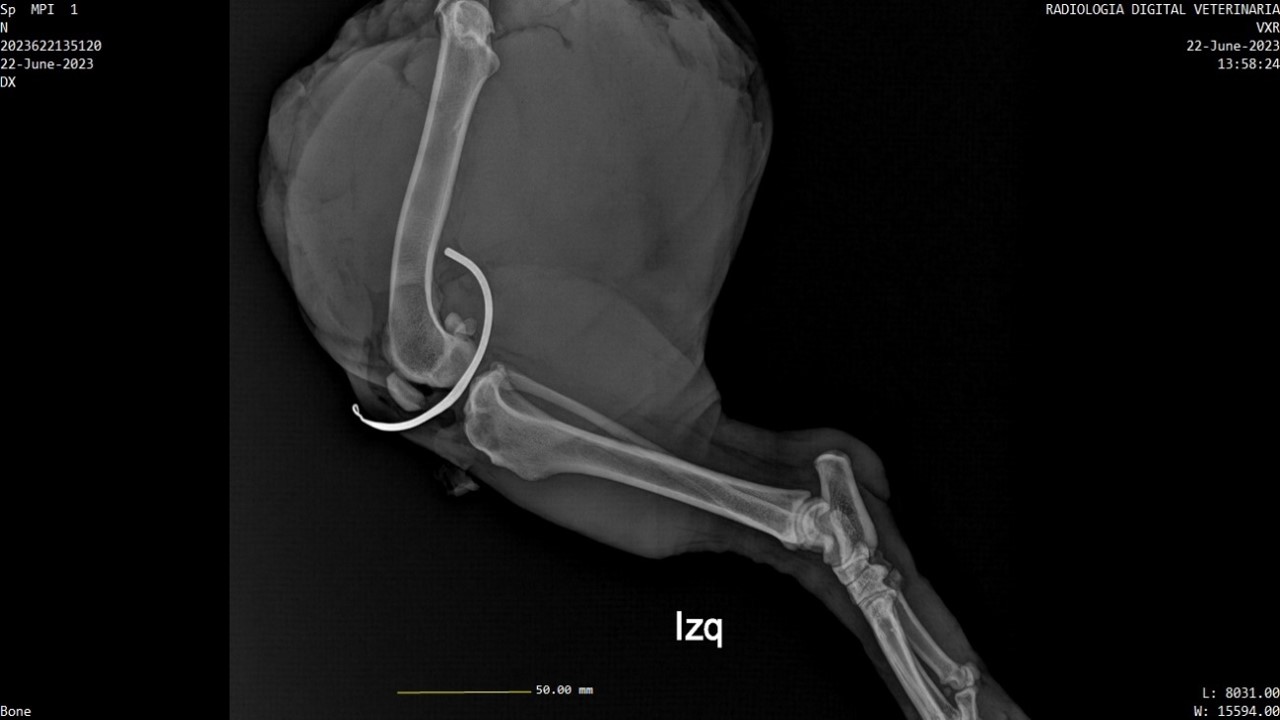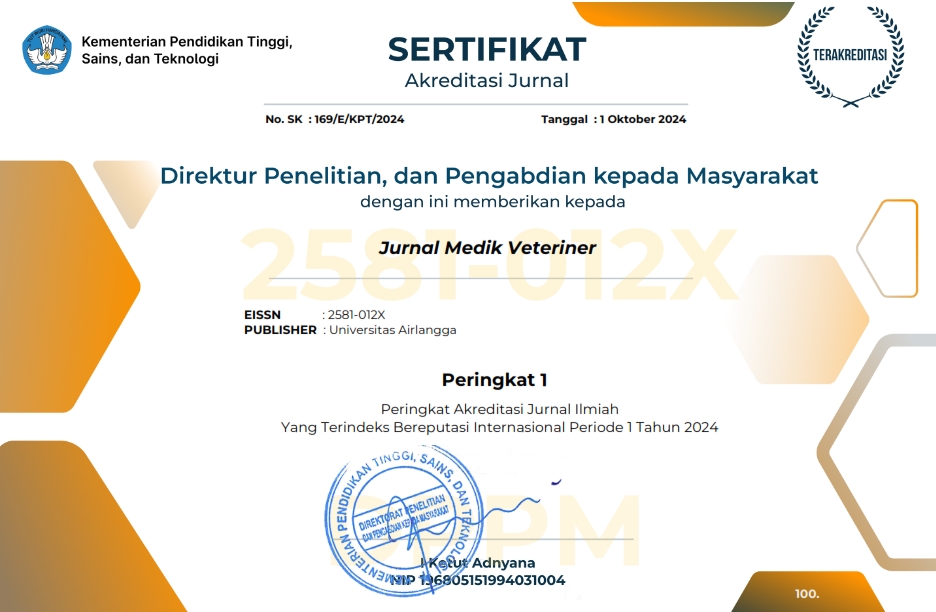Update of Hulse´s Technique for the Surgical Correction of Cranial Cruciate Ligament Rupture and Its Long-Term Postoperative Evaluation in a Group of Canines

Downloads
Rupture of the cranial cruciate ligament is the oldest and most prevalent cause of osteoarthrosis (OA) of the patellofemoral joint (PFJ) in canines, being 75% of all PFJ surgical pathologies. To assess the long term clinical, radiological and orthopaedic results of a modification of Hulse’s technique for intracapsular surgical correction of cranial cruciate ligament rupture (CrCLR). A heterogeneous population of 12 canines who had undergone surgery for CrCLR was called for the study, of which 3 underwent surgery on both PFJs. The technique was modified by using a pre folded crochet needle and a tiny lateral arthrotomy performed just under the lateral collateral ligament. This study was done after 20 months on average from de surgery (range 8 to 36 months) and all the surgeries were performed by the same surgeon. All animals were monitored during the study period, which lasted 4 months. A blind radiological assessment of 3 observers was performed using the Bioarth scale, an orthopaedic assessment to quantify the degree of claudication and PFJ angles (goniometry) and two scales were also used for the assessment of chronic pain and animal welfare i.e., Helsinki's scale and CPBI (canine pain brief inventory). The radiographic assessment of OA yielded a mean of 9.13, with SD of 5.50 and a SE of 1.42. The average subjective assessment of OA according to the Bioarth scale was moderate. The qualitative orthopedic assessment showed that 7 patients did not present claudication, 4 patients showed grade 1 claudication and one grade 2. The CPBI and Helsinki animal welfare scales showed an excellent subjective assessment by the tutors. The Hulse technique, modified with a crochet needle, was sufficient to surgically correct the CrCLR in an heterogeneous population of 12 canines, achieving that all patients functionally used the operated limb or limbs, possessing a very good to excellent quality of life according to their owners, despite having evidenced a moderate degree of OA with an average of 9.13 on the Bioarth scale.
Agostinho, F. S., Rahal, S. C., Miqueleto, N. S. M. L., Verdugo, M. R., Inamassu, L. R., & El-Warrak, A. O. (2011). Kinematic analysis of Labrador Retrievers and Rottweilers trotting on a treadmill. Veterinary and Comparative Orthopaedics and Traumatology, 24(3), 185–191.
Allen, D. A., Wilson, E. R., Lineberger, J. A., Lehenbauer, T., & Moeller, E. M. (2010). Long-term outcomes of thigh circumference, stifle range-of-motion, and lameness after unilateral tibial plateau levelling osteotomy. Veterinary and Comparative Orthopaedics and Traumatology, 23(01), 37–42.
Amimoto, H., Koreeda, T., & Wada, N. (2019). Evaluation of recovery of limb function by use of force plate gait analysis after tibial plateau leveling osteotomy for management of dogs with unilateral cranial cruciate ligament rupture. American Journal of Veterinary Research, 80(5), 461–468.
Aragon, C. L., & Budsberg, S. C. (2005). Applications of Evidence-Based Medicine: Cranial Cruciate Ligament Injury Repair in the Dog. Veterinary Surgery, 34(2), 93–98.
Bergh, M. S., Sullivan, C., Ferrell, C. L., Troy, J., & Budsberg, S. C. (2014). Systematic Review of Surgical Treatments for Cranial Cruciate Ligament Disease in Dogs. Journal of the American Animal Hospital Association, 50(5), 315–321.
Boudrieau, R. J. (2009). Tibial Plateau Leveling Osteotomy or Tibial Tuberosity Advancement? Veterinary Surgery, 38(1), 1–22.
Brown, D. C., Boston, R. C., Coyne, J. C., & Farrar, J. T. (2007). Development and psychometric testing of an instrument designed to measure chronic pain in dogs with osteoarthritis. American Journal of Veterinary Research, 68(6), 631–637.
Butler, D. L., Hulse, D. A., Kay, M. D., Grood, E. S., Shires, P. K., D’Ambrosia, R., & Shoji, H. (1983). Biomechanics of Cranial Cruciate Ligament Reconstruction in the Dog II. Mechanical Properties. Veterinary Surgery, 12(3), 113–118.
Carlin, I. (1926). Ruptur des Ligamentum anterius im Kniegelenk beim Hund. Arch. Wissensch. Prakt. Tierheilk., Berlin, 420–423.
Christopher, S. A., Beetem, J., & Cook, J. L. (2013). Comparison of Long-Term Outcomes Associated With Three Surgical Techniques for Treatment of Cranial Cruciate Ligament Disease in Dogs. Veterinary Surgery, 42(3), 329–334.
Cook, J. L., Evans, R., Conzemius, M. G., Lascelles, B. D. X., McIlwraith, C. W., Pozzi, A., & Stewart, A. (2010). Proposed Definitions and Criteria for Reporting Time Frame, Outcome, and Complications For Clinical Orthopedic Studies in Veterinary Medicine. Veterinary Surgery, 39(8), 905–908.
Cook, J. L., Luther, J. K., Beetem, J., Karnes, J., & Cook, C. R. (2010). Clinical Comparison of a Novel Extracapsular Stabilization Procedure and Tibial Plateau Leveling Osteotomy for Treatment of Cranial Cruciate Ligament Deficiency in Dogs. Veterinary Surgery, 39(3), 315–323.
Coskun, Ö., & Viskjer, S. (2023). Evaluating the outcome after center of rotation of angulation (CORA)-based leveling osteotomy (CBLO) technique to repair unilateral cranial cruciate ligament deficiency using a pressure-sensitive walkway system. Canadian Journal of Veterinary Research, 87(2), 157–164.
Da Silva, A., Junqueira, R., Fonseca, C., Rezende, S., & Filho, A. (2000). Aspectos macro e microscópicos da fáscia lata utilizada como substituto autógeno do ligamento cruzado cranial: estudo experimental em cães. Ciência Rural, 30(2), 275–280.
De Camp, C. E., Johnston, S. A., Déjardin, L. M., & Schaefer S. L. (2016). The stifle joint in Brinker, Piermattei, and Flo’s Handbook of Small Animal Orthopedics and Fracture Repair (5th Ed.) Elsevier, pp: 616–618.
Della Valle, G., Caterino, C., Aragosa, F., Micieli, F., Costanza, D., & Di Palma, C. (2021) Outcome after Modified Maquet Procedure in dogs with unilateral cranial cruciate ligament rupture: Evaluation of recovery limb function by use of force plate gait analysis. PLoS ONE, 16(8), e0256011.
Do Nascimento, R., & Fantinel, N (2022). Técnica de Hulse modificada para estabilização intra-articular do joelho de cães: 15 casos. Pubvet, 16(05), 1–6.
Dokic, Z., Lorinson, D., Weigel, J. P., & Vezzoni, A. (2015). Patellar groove replacement in patellar luxation with severe femoro-patellar osteoarthritis. Veterinary and Comparative Orthopaedics and Traumatology, 28(2), 124–130.
Hellyer, P., Rodan, I., Brunt, J., Downing, R., Haegedorn, J., & Robertson, S. (2007). AAHA/AAFP pain management guidelines for dogs and cats. Journal of Feline Medicine & Surgery, 9(6), 466–480.
Hielm-Björkman, A. K., Kapatkin, A. S., & Rita, H. J. (2011). Reliability and validity of a visual analogue scale used by owners to measure chronic pain attributable to osteoarthritis in their dogs. American Journal of Veterinary Research, 72(5), 601–607.
Hielm-Björkman, A. K., Rita, H., & Tulamo, R. M. (2009). Psychometric testing of the Helsinki chronic pain index by completion of a questionnaire in Finnish by owners of dogs with chronic signs of pain caused by osteoarthritis. American Journal of Veterinary Research, 70(6), 727–734.
Hulse, D. A., Butler, D. L., Kay, M. D., Noyes, F. R., Shires, P. K., D’Ambrosia, R., & Shoji, H. (1983). Biomechanics of Cranial Cruciate Ligament Reconstruction in the Dog I. In Vitro Laxity Testing. Veterinary Surgery, 12(3), 109–112.
Hulse, D. A., Michaelson, F., Johnson, C., & Abdelbaki, Y. Z. (1980). A Technique for Reconstruction of the Anterior Cruciate Ligament in the Dog: Preliminary Report. Veterinary Surgery, 9(4), 135–140.
Hulse, D., Beale, B., & Kowaleski, M. (2010). CORA based leveling osteotomy for the treatment of the CCL deficient stifle (abstract). In: Proceedings of the World Orthopaedic Veterinary Congress. Bologna, Italy, 120 – 121.
Jaegger, G., Marcellin-Little, D. J., & Levine, D. (2002). Reliability of goniometry in Labrador Retrievers. American Journal of Veterinary Research, 63(7), 979–986.
Jandi, A. S., & Schulman, A. J. (2007). Incidence of Motion Loss of the Stifle Joint in Dogs with Naturally Occurring Cranial Cruciate Ligament Rupture Surgically Treated with Tibial Plateau Leveling Osteotomy: Longitudinal Clinical Study of 412 Cases. Veterinary Surgery, 36(2), 114–121.
Kim, S. E., Pozzi, A., Kowaleski, M. P., & Lewis, D. D. (2008). Tibial Osteotomies for Cranial Cruciate Ligament Insufficiency in Dogs. Veterinary Surgery, 37(2), 111–125.
Kishi, E. N., & Hulse, D. (2016). Owner Evaluation of a CORA-Based Leveling Osteotomy for Treatment of Cranial Cruciate Ligament Injury in Dogs. Veterinary Surgery, 45(4), 507–514.
Kowaleski, M. P., Boudrieau, R. J. & Pozzi, A. (2017). Stifle joint. In: Tobias, K. M., Johnston, S. Veterinary surgery: small animal (2nd edition). St. Louis: Elsevier, 1071–1167.
Krotscheck, U., Nelson, S. A., Todhunter, R. J., Stone, M., & Zhang, Z. (2016). Long Term Functional Outcome of Tibial Tuberosity Advancement vs. Tibial Plateau Leveling Osteotomy and Extracapsular Repair in a Heterogeneous Population of Dogs. Veterinary Surgery, 45(2), 261–268.
Lazar, T. P., Berry, C. R., Dehaan, J. J., Peck, J. N., & Correa, M. (2005). Long-Term Radiographic Comparison of Tibial Plateau Leveling Osteotomy Versus Extracapsular Stabilization for Cranial Cruciate Ligament Rupture in the Dog. Veterinary Surgery, 34(2), 133–141.
Leighton, R. L. (1999). Preferred Method of Repair of Cranial Cruciate Ligament Rupture in Dogs: A Survey of ACVS Diplomates Specializing in Canine Orthopedics Letter to the Editor. Veterinary Surgery, 28(3), 194–194.
McCready, D. J., & Ness, M. G. (2016a). Diagnosis and management of meniscal injury in dogs with cranial cruciate ligament rupture: a systematic literature review. Journal of Small Animal Practice, 57(2), 59–66.
McCready, D. J., & Ness, M. G. (2016b). Systematic review of the prevalence, risk factors, diagnosis and management of meniscal injury in dogs: Part 2. Journal of Small Animal Practice, 57(4), 194–204.
McLaughlin, R. M. (2001). Kinetic and Kinematic Gait Analysis in Dogs. Veterinary Clinics of North America: Small Animal Practice, 31(1), 193–201.
Montavon, P.M., Damur, D.M. & Tepic, S. (2002). Advancement of the tibial tuberosity for treatment of the cranial cruciate deficient stifle. 1st World Orthopedic Veterinary Congress, Munich, Germany, September 5–8, 2002, pp 152.
Mostafa, A. A., Griffon, D. J., Thomas, M. W., & Constable, P. D. (2010). Morphometric Characteristics of the Pelvic Limb Musculature of Labrador Retrievers with and without Cranial Cruciate Ligament Deficiency. Veterinary Surgery, 39(3), 380–389.
Nelson, S. A., Krotscheck, U., Rawlinson, J., Todhunter, R. J., Zhang, Z., & Mohammed, H. (2012). Long-Term Functional Outcome of Tibial Plateau Leveling Osteotomy Versus Extracapsular Repair in a Heterogeneous Population of Dogs. Veterinary Surgery, 42(1), 38–50.
Paatsama S. (1952). Ligament injuries in the canine stifle joint. A clinical and experimental study. PhD Thesis, University of Helsinki, Helsinki, Finland.
Paatsama, S. (1988). Long-standing and traumatic ligament injuries and meniscal ruptures of the canine stifle. Veterinary Radiology, 29(2), 54–56.
Pinna, S., Lanzi, F., & Grassato, L. (2020). Bologna Healing Stifle Injury Index: A Comparison of Three Surgical Techniques for the Treatment of Cranial Cruciate Ligament Rupture in Dogs. Frontiers in Veterinary Science, 7(1).
Pinna, S., Lanzi, F., Cordella, A., & Diana, A. (2019). Relationship between the stage of osteoarthritis before and six months after tibial tuberosity advancement procedure in dogs. PLoS ONE, 14(8), e0219849.
Purnomo, A., Budhi, S., Adji, D., Anggraeni, D., Anggoro, D., Widyarini, S., Chhetri, S., & Purnama, M. T. E. (2022). Radiographic and Histological Evaluation in Canine Femur after Implantation of 304 Stainless-steel-based Plate. Pharmacognosy Journal, 14(4), 388–392.
Putame, G., Terzini, M., Bignardi, C., Beale, B., Hulse, D., Zanetti, E., & Audenino, A. (2019). Surgical Treatments for Canine Anterior Cruciate Ligament Rupture: Assessing Functional Recovery Through Multibody Comparative Analysis. Frontiers in Bioenginering Biotechnology, 7, 180.
Quinn, M. M., Keuler, N. S., Lu, Y., Faria, M. L. E., Muir, P., & Markel, M. D. (2007). Evaluation of Agreement Between Numerical Rating Scales, Visual Analogue Scoring Scales, and Force Plate Gait Analysis in Dogs. Veterinary Surgery, 36(4), 360–367.
Ramírez-Flores, G. I., Del Angel-Caraza, J., Quijano-Hernández, I. A., Hulse, D. A., Beale, B. S., & Victoria-Mora, J. M. (2017). Correlation between osteoarthritic changes in the stifle joint in dogs and the results of orthopedic, radiographic, ultrasonographic and arthroscopic examinations. Veterinary Research Communications, 41(2), 129–137.
Raske, M., Hulse, D., Beale, B., Saunders, W. B., Kishi, E., & Kunze, C. (2013). Stabilization of the CORA Based Leveling Osteotomy for Treatment of Cranial Cruciate Ligament Injury Using a Bone Plate Augmented With a Headless Compression Screw. Veterinary Surgery, 42(6), 759–764.
Sabanci, S. S., & Ocal, M. K. (2016). Comparison of goniometric measurements of the stifle joint in seven breeds of normal dogs. Veterinary and Comparative Orthopaedics and Traumatology, 29(3), 214–219.
Sánchez-Carmona, A., Agut, A., Chico, A., Closa, J., Rial, J., & Velasco, A. (2006). Desarrollo de una Escala de valoración radiológica del grado de Osteoartrosis para las articulaciones de la rodilla y el codo en el perro - ESCALA “BIOARTH". Clinical VetPeq Animal, 26(3), 269–275.
Schlag, A. N., Peycke, L. E., & Hulse, D. A. (2020). Center of rotation of angulation-based leveling osteotomy combined with a coplanar cranial closing wedge ostectomy to manage cranial cruciate ligament insufficiency in dogs with excessive tibial plateau angle. Veterinary Surgery, 13(1).
Slocum, B., & Devine, T. (1984). Cranial tibial wedge osteotomy: a technique for eliminating cranial tibial thrust in cranial cruciate ligament repair. Journal of American Veterinary Medical Association, 184(5), 564–9.
Slocum, B., & Slocum, T. D. (1993). Tibial Plateau Leveling Osteotomy for Repair of Cranial Cruciate Ligament Rupture in the Canine. Veterinary Clinics of North America: Small Animal Practice, 23(4), 777–795.
Sopena Juncosa, J. J., Carrillo Poveda, J. M., & Argibay Fraga, V. (2020). Nuevas técnicas de reparación de la rotura del ligamento cruzado craneal en el perro. La reconstrucción intraarticular fisiológica. Selecciones Veterinarias. Valência, Espanha, 28, 27.
Tonks, C. A., Pozzi, A., Ling, H.-Y., & Lewis, D. D. (2010). The Effects of Extra-Articular Suture Tension on Contact Mechanics of the Lateral Compartment of Cadaveric Stifles Treated with the TightRope CCL®or Lateral Suture Technique. Veterinary Surgery, 39(3), 343–349.
Ueda, H., Matsukawa, T., Watanabe, T., Hosaka, Y. &Takehana, K. (2006). Morphological, biochemical and mechanical features of the cranial cruciate and lateral collateral ligaments in dogs. Okajimas Folia Anatomy Japan, 83(1), 25–31.
Waxman, A. S., Robinson, D. A., Evans, R. B., Hulse, D. A., Innes, J. F., & Conzemius, M. G. (2008). Relationship Between Objective and Subjective Assessment of Limb Function in Normal Dogs with an Experimentally Induced Lameness. Veterinary Surgery, 37(3), 241–246.
Zhalniarovich, Y., Mieszkowska, M., Przyborowska-Zhalniarovich, P., Głodek, J., Sobolewski, A., Waluś, G., & Adamiak, Z. (2018). A novel tibial tuberosity advancement technique with cranial implant fixation (TTA CF): a pilot study in sheep. BMC Veterinary Research, 14(1).
Copyright (c) 2025 Claudia de Aurrecoechea, Álvaro Pinhas

This work is licensed under a Creative Commons Attribution-NonCommercial-ShareAlike 4.0 International License.
Authors who publish in this journal agree to the following terms:
1. The journal allows the author to hold the copyright of the article without restrictions;
2. The journal allows the author(s) to retain publishing rights without restrictions;
3. The legal formal aspect of journal publication accessibility refers to Creative Commons Attribution-NonCommercial-ShareAlike 4.0 International License (CC BY-NC-SA).






11.jpg)




















